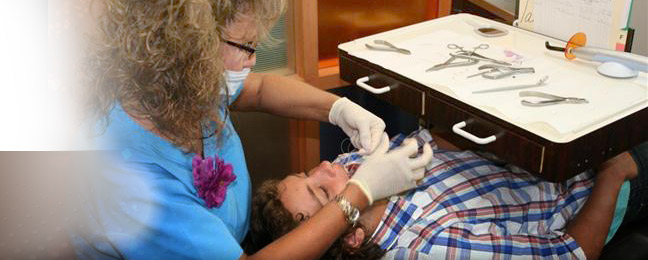Orthodontic Dictionary

Why Braces | For Children and Adults | Two-Phase Treatment | Life with Braces | Brushing & Flossing | Surgical Orthodontics | Orthodontic Dictionary | Emergency Care
Choose a glossary:
» Parts of Braces
» Orthodontic Procedures
» Braces Diagram
Parts of Braces
Appliance: Anything your orthodontist attaches to your teeth which moves your teeth or changes the shape of your jaw.
Archwire: The metal wire that acts as a track to guide your teeth along as they move. It is changed periodically throughout treatment as your teeth move to their new positions.
Band: A metal ring that is cemented to your tooth, going completely around it. Bands provide a way to attach brackets to your teeth.
Bond: The seal created by orthodontic cement that holds your appliances in place.
Bracket: A metal or ceramic part cemented ("bonded") to your tooth that holds your archwire in place.
Coil Spring: A spring that fits between your brackets and over your archwire to open space between your teeth.
Elastic (Rubber Band): A small rubber band that is hooked between different points on your appliance to provide pressure to move your teeth to their new position.
Elastic Tie: The tiny rubber band that fits around your bracket to hold the archwire in place. They come in a variety of colors.
Headgear: Headgear uses an external wire apparatus known as a facebow to gently guide the growth of your face and jaw by moving your teeth into proper position. The force is applied to the facebow by a spring-loaded neck strap or head strap. The straps have a safety release that disconnects if the facebow is pulled or snagged.
Headgear Tube: A round, hollow attachment on your back bands. The inner bow of your headgear fits into it.
Hook: A welded or removable arm to which elastics are attached.
Ligature: A thin wire that holds your archwire into your bracket.
Lip Bumper: A lip bumper is an archwire attached to a molded piece of plastic. The lip bumper holds back the molars on your lower jaw to provide more space for your other teeth.
Mouthguard: A device that protects your mouth from injury when you participate in sports or rigorous activities.
Palatal Expander: A device that makes your upper jaw wider.
Retainer: An appliance that is worn after your braces are removed, the retainer attaches to your upper and/or lower teeth to hold them in place. Some retainers are removable, while others are bonded to the tongue-side of several teeth.
Separator or Spacer: A small rubber ring that creates space between your teeth before the bands are attached.
Tie Wire: A fine wire that is twisted around your bracket to hold the archwire in place.
Wax: Wax is used to stop your braces from irritating your lips.
Orthodontic Procedures
Banding: The process of fitting and cementing orthodontic bands to your teeth.
Bonding: The process of attaching brackets to your teeth using special orthodontic cement.
Cephalometric X-ray: An x-ray of your head which shows the relative positions and growth of the face, jaws, and teeth.
Consultation: A meeting with your orthodontist to discuss a treatment plan.
Debanding: The process of removing cemented orthodontic bands from your teeth.
Debonding: The process of removing cemented orthodontic brackets from your teeth.
Impressions: The process of making a model of your teeth by biting into a soft material that hardens into a mold of your teeth. Your orthodontist will use these impressions to prepare your treatment plan.
Invisalign®: An alternative to traditional braces, Invisalign straightens your teeth with a series of clear custom-molded aligners. Invisalign can correct some, but not all, orthodontic problems.
Ligation: The process of attaching an archwire to the brackets on your teeth.
Panoramic X-ray: An x-ray that rotates around your head to take pictures of your teeth, jaw, and other facial areas.
Braces Diagram
Elastic Tie
Small rubber band that is hooked between different points on the appliance to provide pressure to move the teeth.
Loop in Archwire
Frequently used for closing space left by an extraction. Many archwires don't have a loop.
Archwire
The main wire that acts as a track to guide the teeth along. It's changed periodically throughout treatment, as teeth move to their new positions.
Bracket
Small attachment that holds the archwire in place. Most often, a bracket is cemented directly onto the tooth's surface, eliminating the need for a band.
Headgear Tube
Round, hollow attachment on the back bands. The inner bow of the headgear fits into it.
Coil Spring
Fits between brackets and over archwire to open space between teeth.
Tie Wire
Fine wire that is twisted around the bracket to hold the archwire in place.
Band
A thin ring of metal fitted around a tooth and cemented in place. The band provides a way to attach the brackets to the tooth.
Hook
Welded or removable arm to which elastics (rubber bands) are attached.
Elastic (Rubber Band)
Small rubber band that is hooked between different points on the appliance to provide pressure to move the teeth.